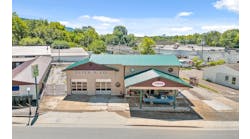Marc Gabbard’s love for cars came from his father.
“My dad was a classic car hobbyist, so I was tinkering around with cars in the garage with him from the time I was in diapers,” Gabbard says. “We built a hot rod as my first car together.”
Gabbard found a real desire and interest in hot rods, and his goal became to open up a hot rod shop. He succeeded, and, eventually, his business grew into collision repair. Today, he owns GSR Collision in Yakima, Wash., where he prioritizes safety first and foremost.
“I think we’ve forgotten to focus on safety,” Gabbard explains. “In years past and decades past, safety wasn’t as big of a concern. Vehicles were made out of mild steel, and basically the idea was that the bigger the vehicle you’re driving, the safer you’re going to be in an accident. Seatbelts were basically the only safety feature cars had for decades.”
That obviously no longer holds true—vehicles have become more automated each year. All of these new systems play a role in how a car will respond to a collision, and altering the structure of a car when repairing it could potentially lead to danger.
“It’s about changing the mindset in the industry that has been in play for decades and stepping back,” Gabbard says. “This is an evolving industry. We have to change how we look at fixing other people’s cars, because cars are different now and they’re going to be different next year and the following year.”
Walk your customer through the process.
Gabbard finds that the premise of keeping the customer happy and appeased just by giving them back their nice shiny car is flawed. His shop has a different approach to customer service.
“We actually pull the curtain back and show them what’s going on behind the scenes,” Gabbard says. “That’s a big part of what’s different about how I run my facility, is involving the consumer and working 100 percent for them.”
Gabbard and his team research every single repair. Instead of using a typical estimator who makes a guestimate at the necessary repairs, GSR Collision does a diagnostic scan immediately. Gabbard sees this scan as a safety necessity.
They make a repair plan based off of dissembling the vehicle and going through the accident in reverse. They also look at the manufacturer's manual about the vehicle’s systems. Then, the customer is brought in once again and given the documentation to show what repairs are necessary and why.
“It’s time-consuming,” Gabbard says. “But, at the end of the day, it’s helping to educate the consumer who’s been kept out of our process for decades.”
Go to bat for your customer.
The way Gabbard runs his shop often differs from expectations, and Gabbard has to help his customers arm themselves with defending the cost of a repair that’s more expensive, but also more comprehensive when it comes to their car’s safety features.
“Sometimes it goes as far as having our customers pay the shortage that their carrier doesn’t want to cover and guiding them to the court systems,” Gabbard explains. “We provide them with the documentation that they need to support it and watch them litigate to get reimbursed for the cost of repairs.”
Not many shops go to this extent, but Gabbard always wants to involve the customer in the process.
“Consumers are grateful to be educated and to be treated like they matter,” Gabbard says.
Use social media to share resources.
Gabbard created the Collision Repair Technicians United Facebook group to share industry knowledge, push others forward, and ultimately find new ways to put the customer and their safety first.
“Every facet of the industry can now connect in real time on social media,” Gabbard explains. “They can share not only just tips and tricks they’ve learned about doing certain aspects of their jobs, but technical information, safety information, different training resources where they can get connected to different types of educators and consultants.”
Gabbard hopes other businesses start following a new way of running a collision facility that prioritizes doing right by the customer.
“Our industry seems to make it easy for shops to make a good living, not necessarily putting the customer in front of them,” Gabbard says. “It makes it easy for a shop to forget who their customer is and that’s been my focus with the group. To really focus on putting the customer front and center and focusing on what’s best for them.”



